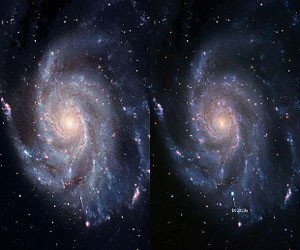The Pinwheel galaxy before, and after the supernova's explosion, courtesy of PTF and the Space Telescope Institute.
SANTA BARBARA, Calif., Dec. 15 (UPI) -- A supernova that exploded in August was a white dwarf star, but its companion could not have been a red giant as previously suspected, U.S. astronomers say.
The new "type Ia" thermonuclear supernova exploded Aug. 24 in the Pinwheel galaxy, located in the constellation Ursa Major, also known as the Big Dipper.
"It's been nearly 50 years since the original theoretical suggestions were made that these supernovae were caused by white dwarfs," physicist Lars Bildsten of the University of California, Santa Barbara, said in a university release Wednesday.
Astrophysicists have discovered type Ia supernovae are part of binary systems, two stars orbiting each other.
White dwarf stars are small but very dense stars, and red giants are stars that swell to massive proportions when they approach middle age.
A white dwarf results when a star similar in size to our sun reaches the end of its life and normally would be dead forever unless it has a companion star.
Then the white dwarf can steal its companion star's matter and come back to life. If it steals too much matter the result can be an explosion as a Type Ia supernova.
Scientists are not yet sure of the type of the companion star to the recent white-dwarf-turned supernova but have ruled out the type of star theories had led them to expect, a red giant.
"This is the first time through direct imaging of the explosion site, we were able to rule out certain types of stars as the companion to a Type Ia supernova," Weidong Li, a research scientist at the University of California, Berkeley said. "The second star couldn't have been a massive red giant."















